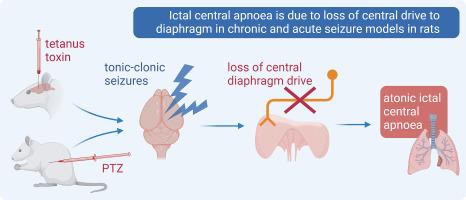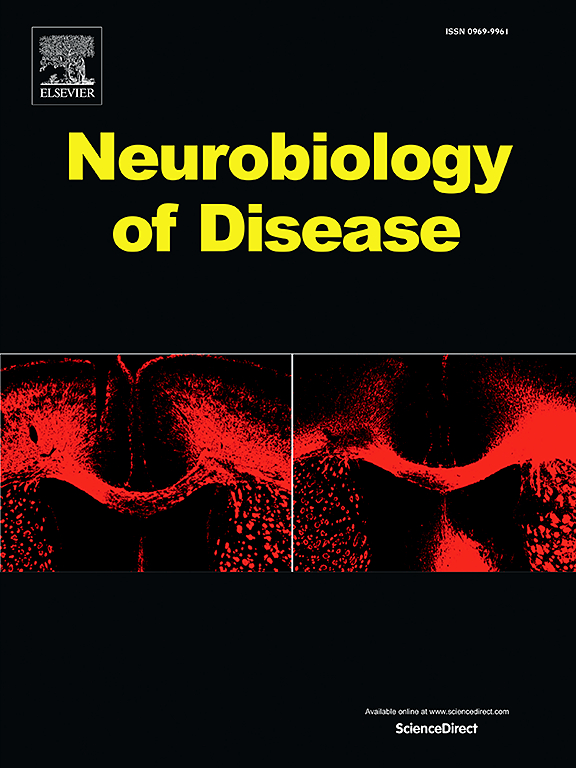Diaphragm relaxation causes seizure-related apnoeas in chronic and acute seizure models in rats
IF 5.1
2区 医学
Q1 NEUROSCIENCES
引用次数: 0
Abstract
Ictal central apnoea is a feature of focal temporal seizures. It is implicated as a risk factor for sudden unexpected death in epilepsy (SUDEP). Here we study seizure-related apnoeas in two different models of experimental seizures, one chronic and one acute, in adult genetically-unmodified rats, to determine mechanisms of seizure-related apnoeas. Under general anaesthesia rats receive sensors for nasal temperature, hippocampal and/or neocortical potentials, and ECG or EMG for subsequent tethered video-telemetry. Tetanus neurotoxin (TeNT), injected into hippocampus during surgery, induces a chronic epileptic focus. Other implanted rats receive intraperitoneal pentylenetetrazol (PTZ) to evoke acute seizures. In chronically epileptic rats, convulsive seizures cause apnoeas (9.9 ± 5.3 s; 331 of 730 convulsive seizures in 15 rats), associated with bradyarrhythmias. Absence of EEG and ECG biomarkers exclude obstructive apnoeas. All eight TeNT-rats with diaphragm EMG have apnoeas with no evidence of obstruction, and have apnoea EMGs significantly closer to expiratory relaxation than inspiratory contraction during pre-apnoeic respiration, which we term “atonic diaphragm”. Consistent with atonic diaphragm is that the pre-apnoeic nasal airflow is expiration, as it is in human ictal central apnoea. Two cases of rat sudden death occur. One, with telemetry to the end, reveals a lethal apnoea, the other only has video during the final days, which reveals cessation of breathing shortly after the last clonic epileptic movement. Telemetry following acute systemic PTZ reveals repeated seizures and seizure-related apnoeas, culminating in lethal apnoeas; ictal apnoeas are central – in 8 of 35 cases diaphragms initially contract tonically for 8.5 ± 15.0 s before relaxing, in the 27 remaining cases diaphragms are atonic throughout apnoeas. All terminal apnoeas are atonic. Differences in types of apnoea due to systemic PTZ in rats (mainly atonic) and mice (tonic) are likely species-specific. Certain genetic mouse models have apnoeas caused by tonic contraction, potentially due to expression of epileptogenic mutations throughout the brain, including in respiratory centres, in contrast with acquired focal epilepsies. We conclude that ictal apnoeas in the rat TeNT model result from atonic diaphragms. Relaxed diaphragms could be particularly helpful for therapeutic stimulation of the diaphragm to help restore respiration.

在大鼠的慢性和急性癫痫模型中,横膈膜放松会导致与癫痫发作相关的呼吸暂停。
颞叶局灶性中枢性呼吸暂停是颞叶局灶性癫痫发作的一个特征。它被认为是癫痫猝死(SUDEP)的一个危险因素。在这里,我们对两种不同的实验性癫痫发作模型(一种是慢性模型,一种是急性模型)进行了研究,以确定癫痫发作相关性呼吸暂停的机制。大鼠在全身麻醉状态下接受鼻温、海马和/或新皮质电位传感器以及心电图或肌电图传感器,以便随后进行系留视频遥测。手术中向海马注射破伤风神经毒素(TeNT),诱发慢性癫痫灶。其他植入大鼠腹腔注射戊四唑(PTZ),诱发急性癫痫发作。在慢性癫痫大鼠中,抽搐发作会导致呼吸暂停(9.9 ± 5.3 秒;15 只大鼠的 730 次抽搐发作中的 331 次),并伴有缓慢性心律失常。脑电图和心电图生物标志物的缺失排除了阻塞性呼吸暂停。所有 8 只具有膈肌肌电图的 TeNT 大鼠都有呼吸暂停,但没有阻塞的证据,而且在呼吸暂停前的呼吸过程中,呼吸暂停肌电图明显更接近呼气放松,而不是吸气收缩,我们称之为 "失张性膈肌"。与无张力膈相一致的是,在发作性中枢性呼吸暂停时,呼吸前鼻腔气流为呼气。有两例大鼠猝死。其中一例直到最后都进行了遥测,显示出致命的呼吸暂停,另一例只有最后几天的视频,显示出在最后一次阵挛性癫痫运动后不久呼吸停止。急性全身性 PTZ 后的遥测显示癫痫反复发作和与发作相关的呼吸暂停,最终导致致命性呼吸暂停;发作性呼吸暂停是中枢性的 - 35 个病例中有 8 个病例的膈肌最初呈强直性收缩,持续 8.5 ± 15.0 秒后放松,其余 27 个病例的膈肌在整个呼吸暂停过程中呈失张力状态。所有终末性呼吸暂停均为失张性。大鼠(主要是失张性)和小鼠(强直性)全身性 PTZ 引起的呼吸暂停类型的差异可能是物种特异性的。某些遗传小鼠模型的呼吸暂停是由强直性收缩引起的,这可能是由于致痫突变在整个大脑(包括呼吸中枢)的表达,这与获得性局灶性癫痫不同。我们的结论是,大鼠 TeNT 模型中的发作性呼吸暂停源于失张力膈肌。放松的膈肌尤其有助于对膈肌进行治疗性刺激,从而帮助恢复呼吸。
本文章由计算机程序翻译,如有差异,请以英文原文为准。
求助全文
约1分钟内获得全文
求助全文
来源期刊

Neurobiology of Disease
医学-神经科学
CiteScore
11.20
自引率
3.30%
发文量
270
审稿时长
76 days
期刊介绍:
Neurobiology of Disease is a major international journal at the interface between basic and clinical neuroscience. The journal provides a forum for the publication of top quality research papers on: molecular and cellular definitions of disease mechanisms, the neural systems and underpinning behavioral disorders, the genetics of inherited neurological and psychiatric diseases, nervous system aging, and findings relevant to the development of new therapies.
 求助内容:
求助内容: 应助结果提醒方式:
应助结果提醒方式:


